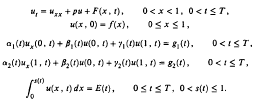Crossref Citations
This article has been cited by the following publications. This list is generated based on data provided by Crossref.
Ivanchov, N. I.
1995.
On the determination of unknown source in the heat equation with nonlocal boundary conditions.
Ukrainian Mathematical Journal,
Vol. 47,
Issue. 10,
p.
1647.
Ivanchov, M. I.
1998.
The inverse problem of determining the heat source power for a parabolic equation under arbitrary boundary conditions.
Journal of Mathematical Sciences,
Vol. 88,
Issue. 3,
p.
432.
Ang, Whye-Teong
Ang, Keng-Cheng
and
Dehghan, Mehdi
2003.
The Determination Of A Control Parameter In A Two-Dimensional Diffusion Equation Using A Dual-Reciprocity Boundary Element Method.
International Journal of Computer Mathematics,
Vol. 80,
Issue. 1,
p.
65.
Dehghan, Mehdi
2004.
Numerical computation of a control function in a partial differential equation.
Applied Mathematics and Computation,
Vol. 147,
Issue. 2,
p.
397.
Trucu, D
Ingham, D B
and
Lesnic, D
2008.
Inverse time-dependent perfusion coefficient identification.
Journal of Physics: Conference Series,
Vol. 124,
Issue. ,
p.
012050.
Shidfar, A.
Zolfaghari, R.
and
Damirchi, J.
2009.
Application of Sinc-collocation method for solving an inverse problem.
Journal of Computational and Applied Mathematics,
Vol. 233,
Issue. 2,
p.
545.
Ismailov, Mansur I.
and
Kanca, Fatma
2011.
An inverse coefficient problem for a parabolic equation in the case of nonlocal boundary and overdetermination conditions.
Mathematical Methods in the Applied Sciences,
Vol. 34,
Issue. 6,
p.
692.
Бейлина, Наталья Викторовна
and
Beylina, Natalie Viktorovna
2011.
О разрешимости обратной задачи для гиперболического уравнения с интегральным условием переопределения.
Вестник Самарского государственного технического университета. Серия «Физико-математические науки»,
Vol. 2(23),
Issue. ,
p.
34.
Ismailov, M.I.
Kanca, F.
and
Lesnic, D.
2011.
Determination of a time-dependent heat source under nonlocal boundary and integral overdetermination conditions.
Applied Mathematics and Computation,
Vol. 218,
Issue. 8,
p.
4138.
Kanca, Fatma
and
Ismailov, Mansur I.
2012.
The inverse problem of finding the time-dependent diffusion coefficient of the heat equation from integral overdetermination data.
Inverse Problems in Science and Engineering,
Vol. 20,
Issue. 4,
p.
463.
Kerimov, Nazim B.
and
Ismailov, Mansur I.
2012.
An inverse coefficient problem for the heat equation in the case of nonlocal boundary conditions.
Journal of Mathematical Analysis and Applications,
Vol. 396,
Issue. 2,
p.
546.
Snitko, H. A.
2012.
Inverse problem for determination of time-dependent coefficients of a parabolic equation in a free-boundary domain.
Journal of Mathematical Sciences,
Vol. 181,
Issue. 3,
p.
350.
Zolfaghari, Reza
and
Shidfar, Abdollah
2013.
Solving a parabolic PDE with nonlocal boundary conditions using the Sinc method.
Numerical Algorithms,
Vol. 62,
Issue. 3,
p.
411.
Kirane, Mokhtar
Malik, Salman A.
and
Al‐Gwaiz, Mohammed A.
2013.
An inverse source problem for a two dimensional time fractional diffusion equation with nonlocal boundary conditions.
Mathematical Methods in the Applied Sciences,
Vol. 36,
Issue. 9,
p.
1056.
Hazanee, A.
and
Lesnic, D.
2013.
Determination of a time-dependent heat source from nonlocal boundary conditions.
Engineering Analysis with Boundary Elements,
Vol. 37,
Issue. 6,
p.
936.
Kanca, Fatma
and
Baglan, Irem Sakinc
2013.
Continuous dependence on data for a solution of the quasilinear parabolic equation with a periodic boundary condition.
Boundary Value Problems,
Vol. 2013,
Issue. 1,
Kanca, Fatma
2013.
Inverse Coefficient Problem of the Parabolic Equation with Periodic Boundary and Integral Overdetermination Conditions.
Abstract and Applied Analysis,
Vol. 2013,
Issue. ,
p.
1.
Kanca, Fatma
2013.
The inverse problem of the heat equation with periodic boundary and integral overdetermination conditions.
Journal of Inequalities and Applications,
Vol. 2013,
Issue. 1,
Zolfaghari, R.
and
Shidfar, A.
2014.
Reconstructing an unknown time-dependent function in the boundary conditions of a parabolic PDE.
Applied Mathematics and Computation,
Vol. 226,
Issue. ,
p.
238.
Snitko, H. A.
2014.
Inverse Problem of Finding Time-Dependent Functions in the Minor Coefficient of a Parabolic Equation in the Domain with Free Boundary.
Journal of Mathematical Sciences,
Vol. 203,
Issue. 1,
p.
40.



